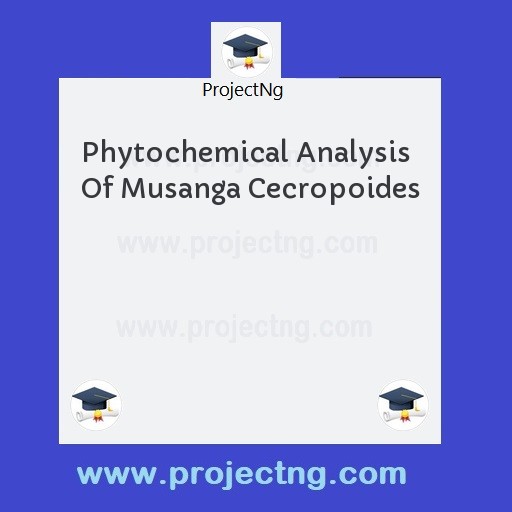Phytochemical Analysis Of Musanga Cecropoides
Science Lab Technology Project Topics
Get the Complete Project Materials Now! »
PHYTOCHEMICAL ANALYSIS OF Musanga cecropoides
ABSTRACT
A standard method was used to carry out a phytochemical analysis on the extraction of Musanga cecropiodes (H3OH:: H2O (4:1). From the research carried out, it was shown that the methanol water extract from the root, leaves and stem of Musanga cecropiodes contained glycosides, flavonoide and saponins. I observed that the glycosides are muscle relaxers and stimulants, Alkaloids and flavonoids also show moderate antifungal and antibacterial activities. I equally observed that saponins show very high activity against bacteria and posses insect repellant properties
CHAPTER ONE
1.0 INTRODUTION
Africa is rich in plant diversity. There are thousands of wild and locally grow medicinal plants available though out of continent. In South Africa alone, there are over 30,000 different species of flowering plants. Among the herbs commonly used in African herbal medicine tradition are following: pellitory, senna, Aloe vera, devils claw, calumba, kolanut and grains of paradise. (Uyannah, 1985).
1.1 HISTORY OF NATURLA PRODUCTS
Natural products can be defined as organic compounds that are formed as a product or by-product of a living organism. Examples of natural product include fibres (eg cotton, silks wool hemp), flues eg (eg oil and natural gas,) construction materials such as wood and rubber and animal by-products like leather. These and many natural products have been used throughout recorded history. One of the most important application of natural products is in the area of health sciences (Okafor, 1983).
A large number of drugs are based on natural products. These can be categorized into four major group: terpenes (which include both toxoids and steroids) glycosides (sugar derivatives that include flavonoids, saponins, anthraglycosides and persistent, occasionally absent; staminodes are scarious, opposite to the perianth lobes. The fruit is usually a dry achene, sometimes a fleshly drupe often enclosed by the persistent perianth.
This family has about 47 genera and 1300 species. They are most numerous in wet tropical regions, extending into temperate regions and consist of 25 genera and 341 species (163 endemic one introduced) in china.
Plant in this family have numerous uses the stem fiber of some genera and species are of high quality and used to make cloth, fishing nets and ropes and for some industrial material. (Brain Alan, 2002).
1.2 AIMS OF STUDY
i. To ascertain the photochemical properties of the Musanga cecropiodies
ii. To determine the mechanical activities involved.
1.3 STATEMENT OF THE PROBLEM
Annous (2005) explain that medicinal plant has lost its value in our society due to lack of experts who could have work hard to extract the active ingredients from these plats.
1.4 SIGNIFICANCE OF THE STUDY
Musanga cecropioides contain phytochemical properties which are of medicinal important to human health. The results of this work will determine if Masanga cecropioides contain phytochemical properties.
1.5 LIMITATIONS OF THE STUDY
This work is limited at the phytochemical analysis of Masanga cecropioides only. Another constraint on this work was poor financial status on my part which was a hindrance during the course of this project work. Moreover, the cost of materials for the project work was high limiting the number of sample for the project work was limited to only phytochemicals.
Be the First to Share On Social

Enjoying our content?
Don't miss out on new videos! Subscribe to our YouTube channel for more awesome content.
Subscribe Now!













